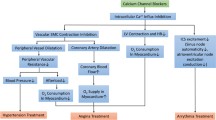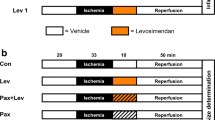Abstract
Potassium channel openers or agonists represent a novel new class of compounds in the treatment of a range of cardiovascular disorders, particularly angina pectoris and hypertension. Nicorandil is the only clinically available potassium channel opener with antianginal effects, and with comparable efficacy and tolerability to existing antianginal therapy. It confers benefits through a dual action: opening the mitochondrial Katp channels leading to preconditioning of the myocardium and a nitrate-like effect. Myocardial preconditioning is important in reducing infarct size, severity of stunning and cardiac arrhythmias. These effects make nicorandil a unique antianginal compound that reduces both pre- and after-load and improves coronary blood flow. Comparative and noncomparative studies support the use of nicorandil as monotherapy or in combination with other antianginal therapy for stable angina pectoris. However, large studies are required to confirm its role in the treatment of acute coronary syndromes despite the favourable results from small studies.

Similar content being viewed by others
References
Noma A. ATP-regulated K+ channels in cardiac muscle. Nature. 1983; 305: 147–8
Shyng S, Nichols C. Octameric stoichiometry of the KATP channel complex. J Gen Physiol 1997; 110: 655–64
Gerald KD, Paucek P, Yarov-Yarooy V, et al. Cardioprotective effect of diazoxide and its interaction with mitochondrial ATP -sensitive K+ channels: possible mechanism of cardioprotection. Circ Res 1997; 81: 1072–82
Liu Y, Sato T, O’Rourke B, et al. Mitochondrial ATP-dependent potassium channels: novel effectors of cardioprotection? Circulation 1998; 97: 2463–9
Sato T, Sasaki N, Seharaseyon J, et al. Selective pharmacological agents implicate mitochondrial but not sarcolemmal K ATPChannels in ischaemic cardioprotection. Circulation 2000; 101: 2418–23
Murry CE, Jennings RB, Reimer KA. Preconditioning with ischaemia a delay of cell injury in ischaemic myocardium. Circulation 1986; 74: 1124–36
Przyklenk K, Bauer B, Ovize M, et al. Regional ischemic ‘preconditioning’ protects remote virgin myocardium from subsequent sustained coronary occlusion. Circulation 1993; 87: 893–9
Gysembergh A, Margonari H, Loufoua J, et al. Stretch-induced protection shares a common mechanism with ischemic preconditioning in rabbit heart. Am J Physiol 1998; 274: H955–H64
Koning MM, Gho BC, van Klaarwater E, et al. Rapid ventricular pacing produces myocardial protection by nonischemic activation of K+ atpchannels. Circulation 1996; 93: 178–86
Hoag JB, Qian YZ, Nayeem MA, et al. ATP-sensitive potassium channel mediates delayed ischemic protection by heat stress in rabbit heart. Am J Physiol 1997; 273: H2458–H64
Gho BC, Schoemaker RG, van den Doel MA, et al. Myocardial protection by brief ischemia in noncardiac tissue. Circulation 1996; 94: 2193–200
Dunker DJ and Verdouw PD. Role of Katp channels in Ischaemic Preconditioning and Cardioprotection. Cardiovas Drugs Ther 2000; 14: 7–16
Tomai F, Crea F, Gaspardone A, et al. Ischaemic preconditioning during coronary angioplasty is prevented by glibenclamide, a selective ATP-sensitive K+ channel blocker. Circulation 1994; 90: 700–5
Marber MS, Joy MD, Yellon DM. Warm-up in angina: is it ischaemic preconditioning? Br Heart J 1994; 72: 213–5
Behar S, Reicher-Reiss H, Abinader E, et al. The prognostic significance of angina pectoris preceding the occurrence of a first acute myocardial infarction in 4166 consecutive hospitalized patients. Am Heart J 1992; 123: 1481–6
Ottani F, Galvani M, Ferrini D, et al. Prodromal angina limits infarct size: a role for ischaemic preconditioning. Circulation 1995; 91: 291–7
Liu GS, Thornton J, Van Winkle DM, et al. Protection against infarction afforded by preconditioning is mediated by A1-adenosine receptors in rabbit heart. Circulation 1991; 84: 350–6
Thornton J, Liu GS, Olsson RA, et al. Intravenous pre-treatment with A1-selective adenosine analogues protects the heart against infarction. Circulation 1992; 85: 659–65
Goto M, Liu Y, Xi-Ming Y, et al. Role os bradykinin in protection of ischemic preconditioning in rabbit hearts. Circ Res 1995; 77: 611–21
Kariya T, Minatoguchi S, Ohno T, et al. Infarct size-reducing effect of ischemic preconditioning is related to alpha/1b-adrenoceptors but not alpha/1a-adrenoceptors in rabbits. J Cardiovasc Pharmacol 1997; 30: 437–45
Tanaka M, Fujiwara H, Yamasaki K, et al. Superoxide dismutase and N-2-mercaptopropionyl glycine attenuate infarct size limitation effect of ischaemic preconditioning in the rabbit. Cardiovasc Res 1994; 28: 980–6
Ytreus K, Liu Y, Downey J. Preconditioning protects ischemic rabbit heart by protein kinase C activation. Am J Physio 1994; 266: HI 145–52
Gross GJ, Auchampach J. Blockade of ATP-sensitive potassium channels prevents myocardial preconditioning in the dogs. Circ Res 1992; 70: 223–33
Light PE, Sabir AA, Allen BG, et al. Protein kinase C-induced changes in the stoichiometry of ATP binding activate cardiac ATP-sensitive K+ channels, a possible mechanistic link to ischemic preconditioning. Circ Res 1996; 79: 399–406
Parratt JR, Kane KA. KATPChannels in ischaemic preconditioning. Cardiovasc Res 1994; 28: 783–7
Flaherty JT. Nitrate tolerance: a review of the evidence. Drugs 1989; 37: 523–50
Kukovetz WR, Holzmann S, Braida C. Dual mechanism of relaxing effect of nicorandil by stimulation of cyclic GMP formation and hyperpolarization. J Cardiovasc Pharmacol 1991; 17: 627–33
Kukovetz WR, Holzmann S, Poch G. Molecular mechanism of action of nicorandil. J Cardiovasc Pharmacol 1992; 20 Suppl. 3.: 1–7
Sato T, Sasaki N, O’Rourke B, et al. Nicorandil, a potent cardioprotective agent, acts by opening mitochondrial ATP-dependent potassium channels. J Am Coll Cardiol 2000; 35: 514–8
Suryapranta H, Macleod D. Nicorandil and cardiovascular performance in patients with coronary artery disease. J Cardiovasc Pharmacol 1992; 20: S45–S51
Krumenacker M, Roland E. Clinical profile of nicorandil: an overview of its hemodynamic properties and therapeutic efficacy. J Cardiovasc Pharmacol 1992; 20: S93–S102
Frydman A. A pharmacological profile of nicorandil in humans: an overview. J Cardiovas Pharmacol 1992; 20: S34–S44
Frampton J, Buckley MM, Fitton A. Nicorandil, a review of its pharmacology and therapeutic efficacy in angina pectoris. Drugs 1992; 44: 625–55
Ulvenstam G, Diderholm E, Frithz G, et al. Antianginal and anti-ischemic efficacy of nicorandil compared to nifedipine in patients with angina pectoris and coronary heart disease: a double-blind randomised multicenter study. J Cardiovasc Pharmacol 1992; 20 Suppl. 3: S67–S73
Guermonprez JL, Blin P, Peterlongo F. A double-blind comparison of the long-term efficacy of a potassium channel opener and a calcium antagonist in stable angina pectoris. Eur Heart J 1993; 14 Suppl. B: 30–4
Doring G. Antianginal and anti-ischemic efficacy of nicorandil in comparison with isosorbide-5-mononitrate and isosorbide dinitrate: results from two multicenter double-blind randomised studies with stable coronary heart disease patients. J Cardiovasc Pharmacol 1992; 20 Suppl. 3: S74–S81
Di Somma S, Liquori V, Verdecchia P, et al. A double blind comparison of nicorandil and metoprolol in patients with effort stable angina [abstract]. Eur Heart J 1990; 11 Suppl.: 80
Hughes LO, Rose EL, Lahiri A, et al. Comparison of nicorandil and atenolol in stable angina pectoris. Am J Cardiol 1990; 66: 679–82
Meeter K, Kelder JC, Tijssen JGP, et al. Efficacy of nicorandil versus propranolol in mild stable angina pectoris of effort. A long-term double-blind randomized study. J Cardiovasc Pharmacol 1992; 20 Suppl. 3: S59–S66
The Swan Study Group. Comparison of the antiischemic and antianginal effects of nicorandil and amlodipine in patients with symptomatic stable angina pectoris: the SWAN study. J Clin Basic Cardiol 1999; 2: 213–7
Why HJF, Richardson PJ. A potassium channel opener as monotherapy in chronic stable angina pectoris: comparison with placebo. Eur Heart J 1993; 14 Suppl. B: 25–9
The IONA Study Group. Trial to show the impact of nicorandil in angina (IONA): design, methodologyt and management [abstract]. Heart 2001; 85: 614
Ciampricotti R, Schotborgh CE, van Herwaarden RH, et al. A comparison of nicorandil with isosorbide mononitrate in elderly patients with stable coronary heart disease: the SNAPE study. Am Heart J May 2000; 139(5): 857
Kishida H, Murao S. Effect of a new coronary vasodilator nicorandil on variant angina pectoris. Clin Pharmacol Ther 1987; 42: 166–74
Lablanche JM, Bauters EP, McFadden EP, et al. Potassium channel activators in vasospastic angina. Eur Heart J 1993; 14 Suppl. B: 22–4
Matsuo H, Matsubara T, Segawa T, et al. Evidence of pharmacological preconditioning during PTCA by intravenous pre-treatment of ATP-sensitive K+ channel opener nicorandil (abstract). J Am Coll Cardiol 1998; 31 Suppl. A: 458A
Patel DJ, Purcell HJ, Fox KM. Cardioprotection by opening of the KATP channels in unstable angina. Eur Heart J 1999; 20: 51–7
Kato K, Iimuna H, Hirosawa K, et al. Clinical evaluation of intravenous SG-75 in treatment of unstable angina: a multicenter double-blind comparative study with intravenous ISDN. Rinshou Iyaku 1991; 7: 2031–54
Sen S, Neuss H, Berg G, et al. Beneficial effects of nicorandil in acute myocardial infarction: a placebo-controlled, double-blind pilot safety study. Br J Cardiol 1998; 4: 208–20
Montogomery H, Suneray M, Carr C, et al. Sinus arrest and severe peripheral vasodilation following cardiopulmonary bypass in a patient taking nicorandil. Cardiovasc Drugs Ther 1997; 11(1):81
Falase BA, Bajaj BS, Wall TJ, et al. Nicorandil-induced peripheral vasodilatation during cardiopulmonary bypass. Ann Thorac Surg 1999; 67(4): 1158–9
Hayashi Y, Sawa Y, Ohtake S, et al. Controlled nicorandil administration for myocardial protection during coronary artery bypass grafting under cardiopulmonary bypass. J Cardiovasc Pharmacol 2001; 38: 21–8
Acknowledgements
No funding was received for the preparation of this manuscript. Henry Purcell and Kim Fox have undertaken clinical trials and spoken at symposia sponsored by Aventis (the manufacturer of nicorandil).
Author information
Authors and Affiliations
Corresponding author
Rights and permissions
About this article
Cite this article
Gomma, A.H., Purcell, H.J. & Fox, K.M. Potassium Channel Openers in Myocardial Ischaemia. Drugs 61, 1705–1710 (2001). https://doi.org/10.2165/00003495-200161120-00002
Published:
Issue Date:
DOI: https://doi.org/10.2165/00003495-200161120-00002




